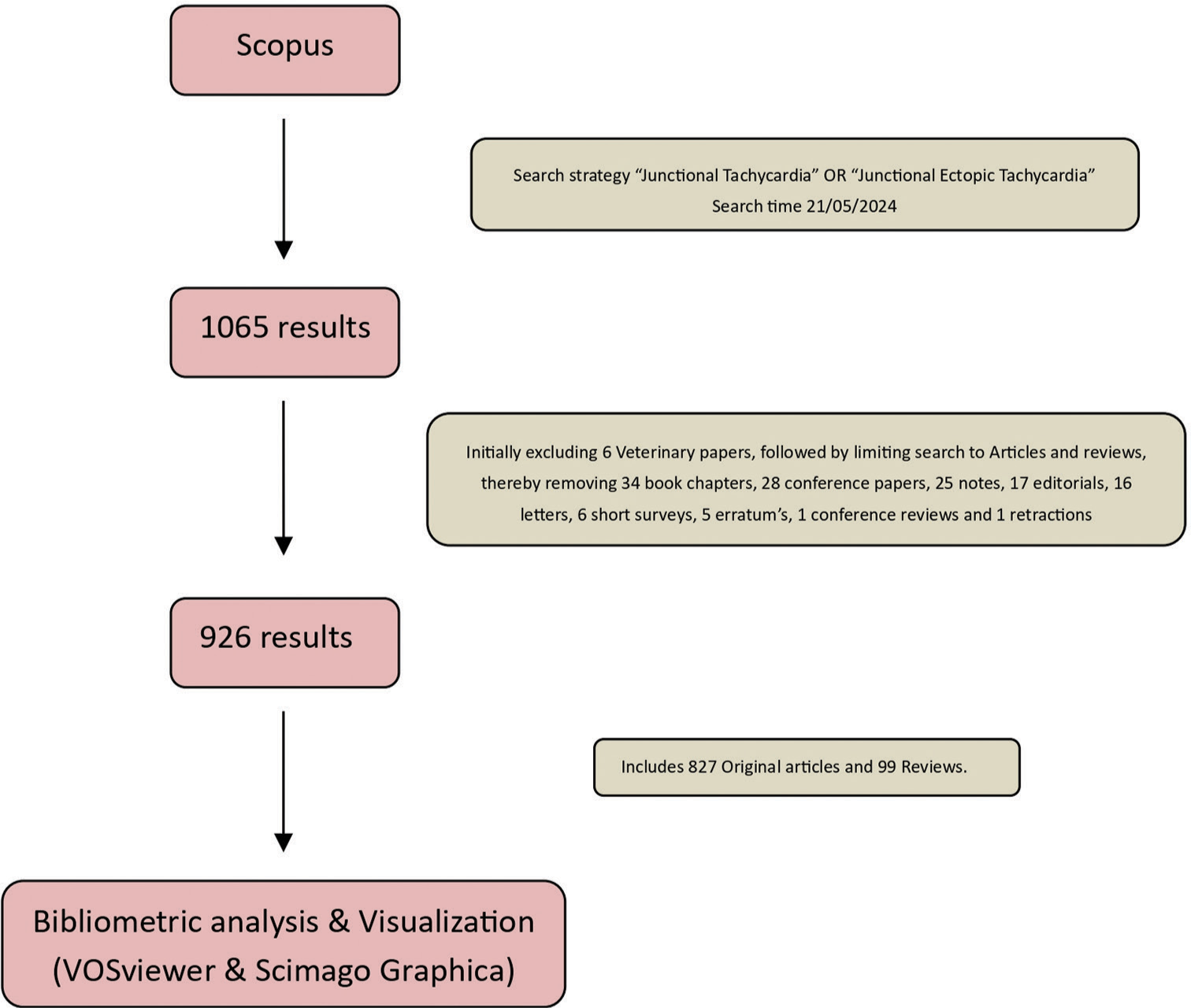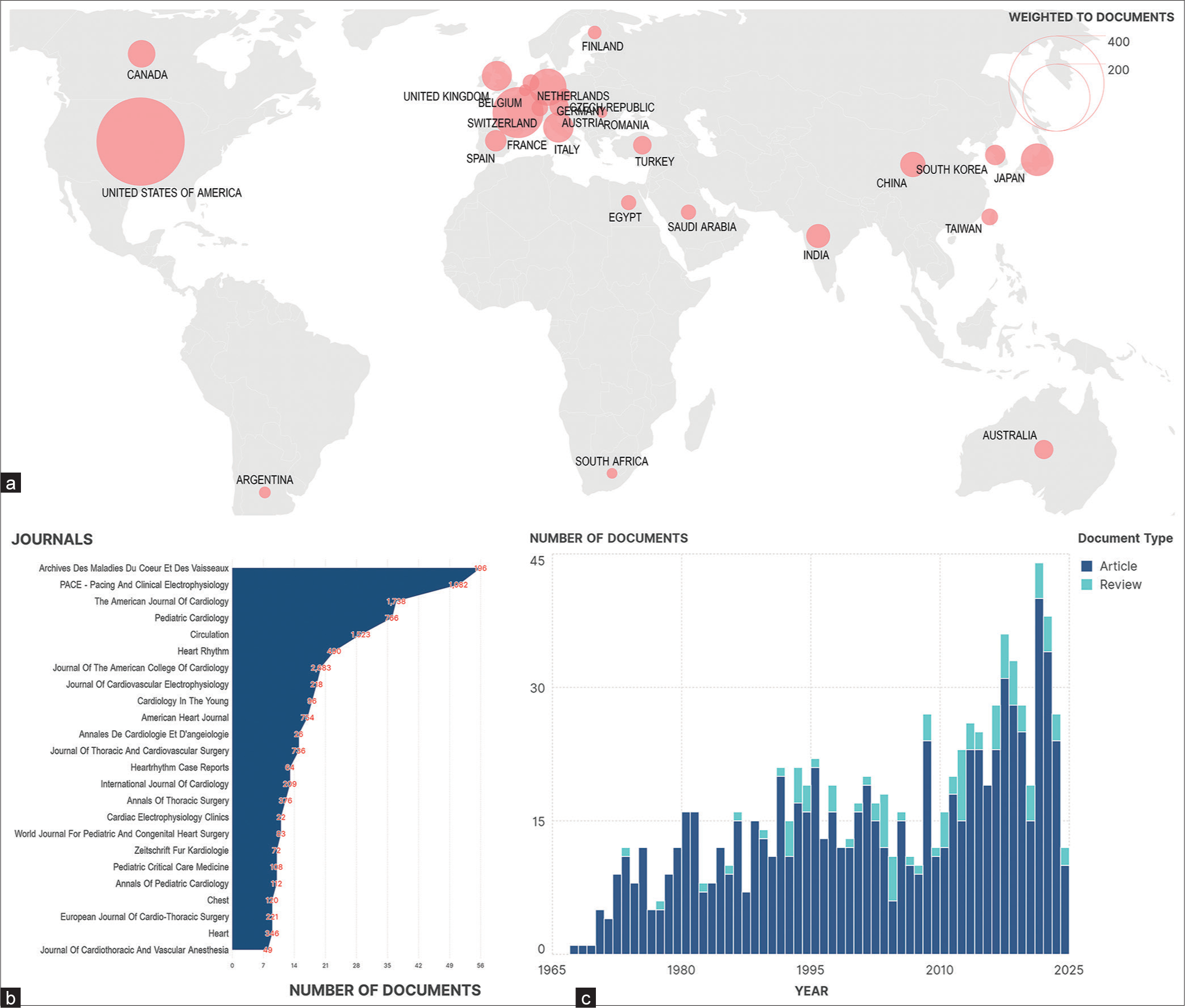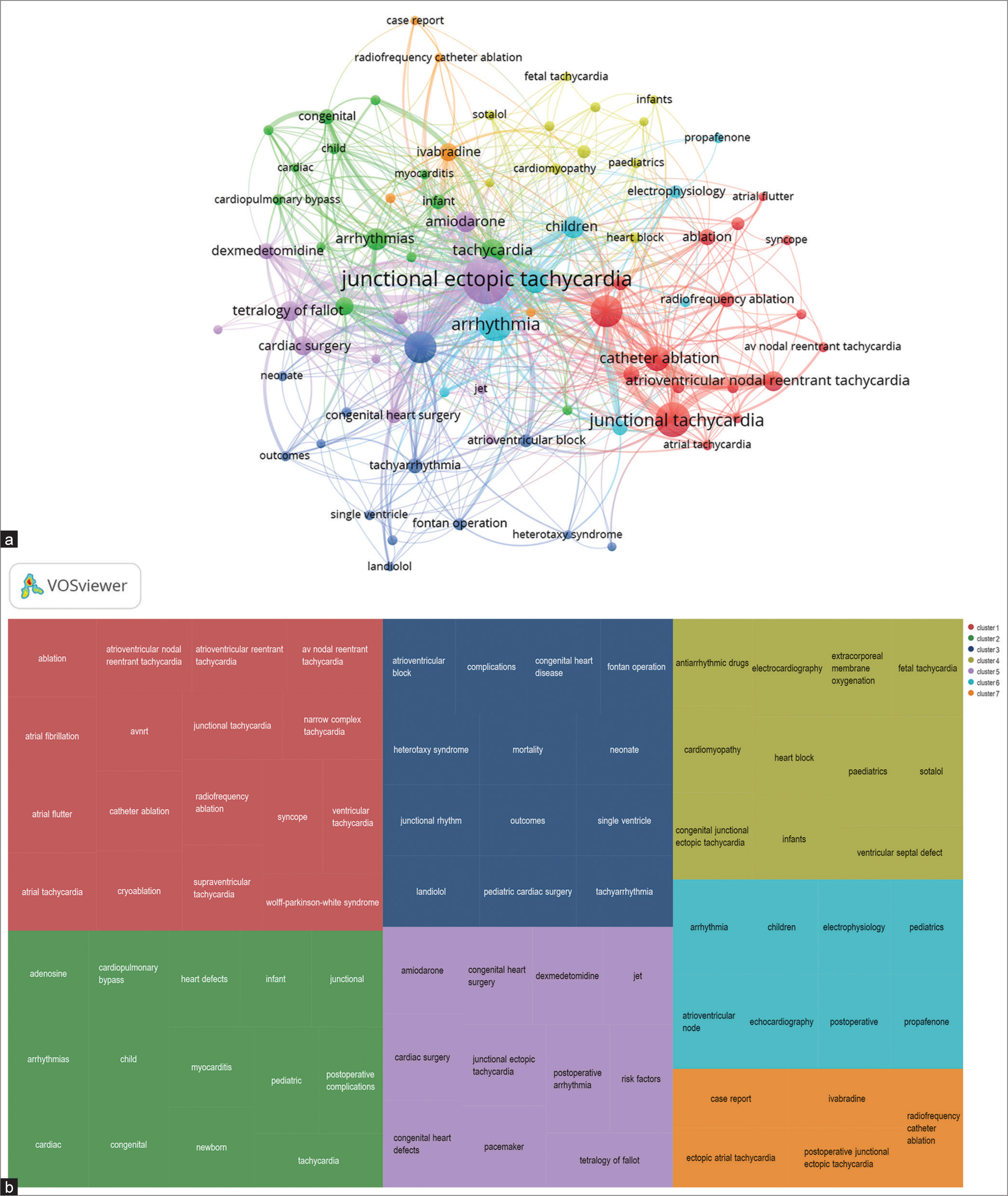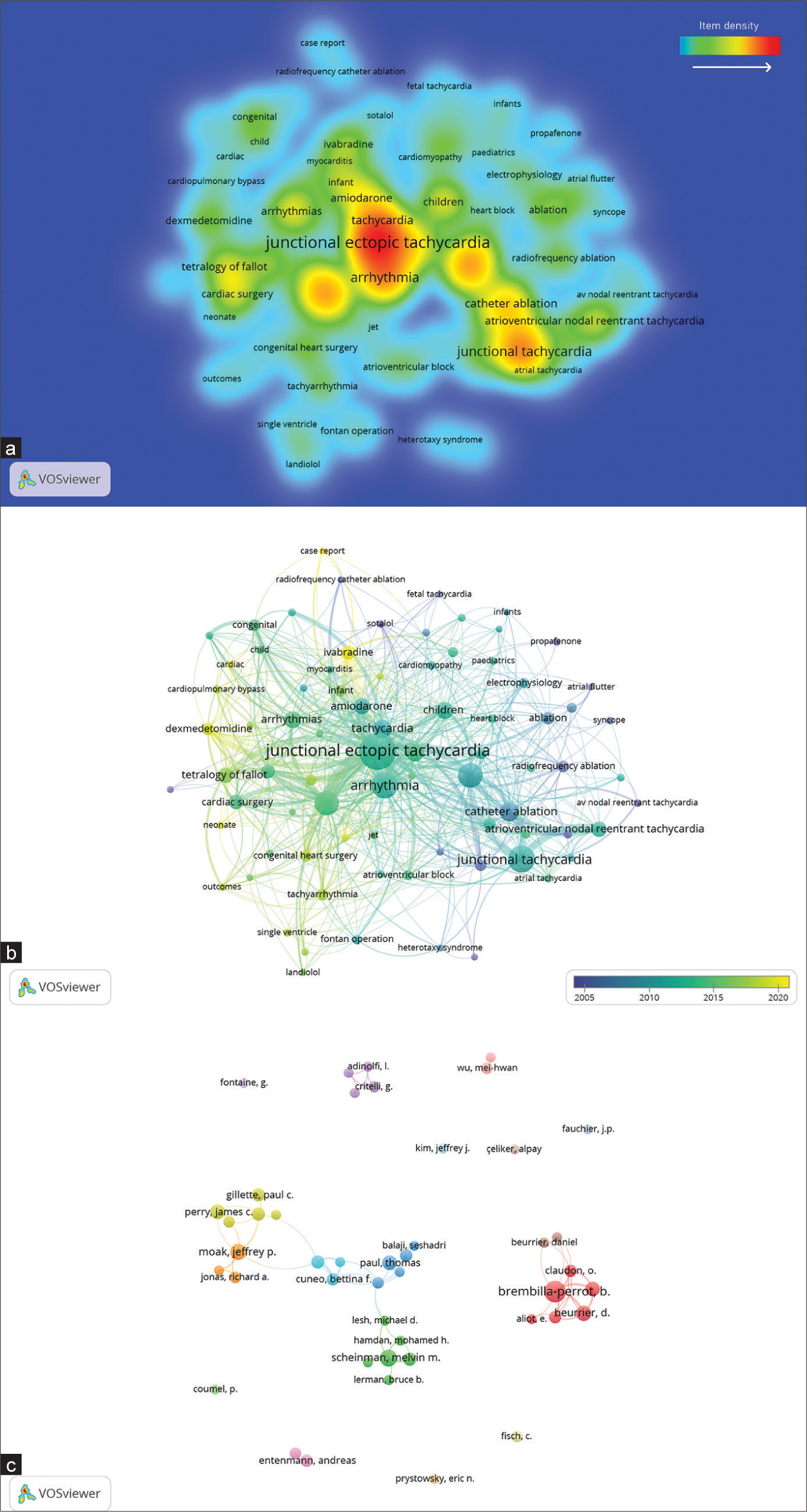Translate this page into:
A Bibliometric Study on Junctional Ectopic Tachycardia: Time and Trends have much to Tell!
*Corresponding author: Varun Suresh, Department of Anesthesia and Intensive Care, Jaber Al Ahmad Al Sabah Hospital, Khalid Ben AbdulAziz Street, Zahra, Arabian Gulf, Kuwait. varunsureshpgi@gmail.com
-
Received: ,
Accepted: ,
How to cite this article: Jose J, Magoon R, Choudhary N, Suresh V, Kumar M. A Bibliometric Study on Junctional Ectopic Tachycardia: Time and Trends have much to Tell! J Card Crit Care TSS. 2024;8:139-46. doi: 10.25259/JCCC_28_2024
Abstract
Objectives:
Junctional ectopic tachycardia (JET), an arrhythmia of substantial clinical relevance, is no less than an eternal nemesis in cardiac critical care. Hence, we hereby present a bibliometric study evaluating the research trends in the subject.
Material and Methods:
A Scopus search-based bibliometric analysis of the keyword “Junctional Tachycardia” OR “Junctional Ectopic Tachycardia” restricted to original articles and reviews was undertaken after excluding the veterinary-related papers. The metadata thus obtained was analyzed using Scimago Graphica 1.0.42 and VOSviewer version 1.6.20 to generate a graphical representation of the trends and the timelines based on the author keywords.
Results:
A total of 926 papers of interest were identified and selected for the analysis, which revealed the geographical distribution of productivity being primarily concentrated in the Western developed nations, topic receptiveness largely appreciated in cardiovascular-related journals, and increased yearly output of the JET-associated papers. Further perusal identified 79 most frequently observed author keywords when limited to a minimum of 5 co-occurrences, which were grouped into seven color-coded clusters by VOSviewer, and mapped into keyword as well as author network, overlay, and density projections.
Conclusion:
Bibliometric analysis of JET papers from 1967 to 2024 shows a growing interest in the topic, awaiting newer insights into the molecular mechanisms and the preventative treatment strategies.
Keywords
Arrhythmia
Cardiac surgery
Junctional tachycardia
Pediatric
Postoperative
INTRODUCTION
Junctional ectopic tachycardia (JET), also known as junctional tachycardia, has been classically described as a paroxysmal, non-re-entrant supraventricular tachycardia that emanates from abnormal automaticity of the tissue located within the atrioventricular (AV) junction, especially the AV node and the His bundle.[1] The previous studies report an incidence of JET to hover between 5.6% and 14%, entailing a mortality rate ranging from 8.3% to as high as 40%, depending on the patient subset involved.[2,3] JET, however, based on etiology, can be broadly classified into two distinct subtypes, namely, congenital JET (CJET) and post-operative JET (POJET). CJET, which usually presents within the first 6 months of life as unexplained tachycardia, despite its’ rarity, often results in sudden cardiac death as well as cardiomegaly and heart failure in up to 60%.[3,4] Conversely, POJET is more frequently observed within the first 24–48 hours following cardiac surgery, particularly in the pediatric population, secondary to direct surgical trauma, ischemia, and stretch of the AV conduction tissue.[5] Over the years, various randomized control trials like the one published by Makhoul et al. in 2013 and even a meta-analysis conducted on the drugs for JET prophylaxis in 2022 by Mendel et al. have attempted to unravel this enigmatic complex arrhythmia and the associated debilitating impact.[6,7]
Having said that diverse reported incidences, involvement of a multifaceted etiology, and an ongoing quest for preventative as well as therapeutic strategies make JET an interesting topic where perioperative factors are expected to play a pivotal role. Hence, we decided to conduct a bibliometric analysis to comprehensively elucidate the currently available knowledge network and the global research trends in JET.
MATERIAL AND METHODS
Data collection and search strategy
The data subset required for the bibliometric analysis was obtained through a Scopus (https://www.scopus.com/search/form.uri?display=basic#basic) search. The corresponding protocol is displayed below, wherein the keyword “Junctional Tachycardia” OR “Junctional Ectopic Tachycardia” was searched to obtain the preliminary results. These results were further refined by excluding the veterinary-related papers, which was followed by limiting the search further to the articles and reviews, giving the final paper count [Figure 1]. The metadata from the entire timeline, from January 1967 to May 2024, including the ahead-of-print versions, were considered, and a comma-separated value (.csv) file was downloaded for the subsequent analysis.

- Flowchart of the literature search and screening process.
Data analysis
To ensure the accuracy and fidelity of the bibliometric study, two separate researchers extracted the data from Scopus and independently assessed the same. Scimago Graphica 1.0.42 (Scimago Lab, Spain) and VOSviewer version 1.6.20 (Leiden University Centre for Science and Technology Studies, Netherlands) were utilized herein to analyze the data. The top 25 countries and the journals, as well as the global yearly output of JET research based on the number of documents, were visualized with Scimago Graphica. VOSviewer was employed to generate the author keywords, which were narrowed down with a minimum keyword co-occurrence limit of 5. This was further perused to conceptualize the pattern of the weighted total link strength (network, overlay, and density), the keyword co-occurrence, research hotspots in JET, and the clustering of keywords as per the VOSviewer.
RESULTS
Trends in publications
A total of 1065 papers were identified on Scopus during the preliminary search. These results were fine-tuned by excluding six veterinary-related papers, limiting to original articles and reviews, having excluded 34 book chapters, 28 conference papers, 25 notes, 17 editorials, 16 letters, 6 short surveys, 5 erratum, 1 conference review, and 1 retraction. Hence, a final paper count of 926 was included, of which 827 (89%) were original articles and 99 (11%) were reviews. First, a bubble map [Figure 2a] depicting the top 25 countries weighted to an overall number of documents produced over the years was created using Scimago Graphica. This outlined the United States of America (USA) to be leading the research front with a total of 339 articles during this study period. Figure 2b represents the top 25 journals based on the total number of papers published. Out of this, the journal Archives des Maladies du Cœur et des Vaisseaux topped the charts with 56 publications, which was closely followed by Pacing and Clinical Electrophysiology (PACE), having a grand total of 51 papers. Of the total of 926 articles, about eight articles had an excess of 200 citations each, which could arguably be labeled as landmark publications in the field. However, [Table 1] portrays a very different picture, with the Journal of American College of Cardiology (JACC) bagging the most number of citations, at 2683 from 20 papers, almost 13.5 times as many citations as Archives des Maladies du Cœur et des Vaisseaux.

- Graphical representation of JET-related research output weighted to the number of documents using Scimago Graphica. (a) Bubble visualization of the top 25 countries superimposed over the world map. (b) Top 25 journals, along with citations received. (c) Timeline with a yearly output of articles and reviews. JET: Junctional ectopic tachycardia.
| S. No. | Journal | TC | TD | IF |
|---|---|---|---|---|
| 1. | Journal of the American College of Cardiology | 2683 | 20 | 24.4 |
| 2. | The American Journal of Cardiology | 1738 | 37 | 2.8 |
| 3. | Circulation | 1523 | 29 | 37.8 |
| 4. | PACE | 1082 | 51 | 1.8 |
| 5. | Pediatric Cardiology | 766 | 36 | 1.6 |
| 6. | American heart journal | 754 | 17 | 4.8 |
| 7. | Journal of thoracic and cardiovascular surgery | 736 | 15 | 6 |
| 8. | Heart rhythm | 490 | 23 | 5.5 |
| 9. | Annals of thoracic surgery | 376 | 12 | 4.6 |
| 10. | Anesthesia and analgesia | 355 | 3 | 5.9 |
TC: Total number of citations, TD: Total number of documents, IF: Impact factor of the journal for the year 2022, JET: Junctional ectopic tachycardia, PACE: Pacing and clinical electrophysiology
The earliest metadata observed during the index study was from 1967, while the latest was published in April 2024 with few still in ahead of print. The timeline of JET research papers based on yearly frequency has been rendered in Figure 2c as a bar graph. Since 1967, the research interest in the topic has gradually risen, with 2008 seeing 26 papers a year, to a recent spike in output seen in 2022, which witnessed 43 articles, of which 39 were original research and four were reviews.
Keyword and author analysis
The search generated a total of 1038 author keywords, which was narrowed down to 79 keyword co-occurrences, as per the set minimum keyword co-occurrence limit of 5. Network visualization analysis of these 79 selected keywords was plotted using the VOSviewer [Figure 3a]. The resulting map further classified these keywords into seven distinct clusters [Figure 3b], each color-coded for easy delineation. The node size within the hotspot connotes the frequency of keyword occurrence, with the inter-connecting line thickness representing the co-occurrence of keywords. Arrhythmia, congenital heart disease, supraventricular tachycardia, catheter ablation, tachycardia, pediatrics, children, arrhythmias, amiodarone, and tetralogy of Fallot were among the ten most frequently used author keywords in decreasing frequency of co-occurrences.

- (a) Network visualization analysis (weighted-to-co-occurrences) of the selected author keywords from Scopus search. (b) Scimago Graphica representation of individual author keyword clusters (in no specific order of frequency) and color-coded to match network visualization.
The cluster density visualization analysis and the overlay analysis of the co-occurred keywords for a period of 15 years (2005–2020), during which significant shifts in keywords were observed by the VOSviewer algorithm, are depicted in Figure 4a and b. The network analysis with a filter of authors with at least five publications on JET found 45 individual authors delineated in [Figure 4c]. Among the authors, B Brembilla-Perrot (CHU de Brabois, France) had the highest number of published papers related to JET at 22 articles and 129 citations, while Bruce B. Lerman (Weill Cornell Medicine, USA) was cited the most, with a citation count of 1120 from 5 JET-related papers.

- (a) Keyword cluster density visualization. (green to red transition denoting increased frequency of co-occurred keyword). (b) Overlay visualization analysis (weighted to co-occurrences) of author keywords related to Scopus search along the timeline. (c) Network visualization analysis of the related authors (weighted to number of documents).
DISCUSSION
The analysis meticulously assessed the patterns and trends in JET publications, alongside endeavoring to map the future directions of JET research. Among 83 countries across the globe contributing research papers on JET during the study timeline, 37% of the papers with around 9299 citations happened to be contributed by the USA, followed by France and Germany [Figure 2a]. This trend bespeaks the medical research facilities in high-income nations with an early history of conducting pediatric cardiac surgeries dating back to 1938.[8,9] The majority were in English (765), French (90), and German (22), with a few in other languages, including Italian, Spanish, Chinese, and Japanese, again reflecting similar trends regarding nationalities of the paper’s origin, in addition to the universal acceptance of English in scientific publications.[10]
The cardiology journals had the maximum share of JET-related publications, followed by allied branches such as cardiac surgery and cardiac anesthesia [Figure 2b]. The Société Française de Cardiologie journal Archives des Maladies du Cœur et des Vaisseaux, although with the highest number of publications, had fewer citations [Table 1]. When compared to the impact factor (IF) of 1.8 for the former French language journal, higher IF English journals such as the JACC, the American Journal Of Cardiology, and the American Heart Association journal Circulation with respective IF’s (as of 2022) 24.4, 2.8, and 37.4, despite of fewer overall publications, led the way in terms of the citation received.[11] Fortunately, the interest in JET has steadily increased [Figure 2c], with the first spike seen around the mid-90s, primarily corresponding to the advancements in cardiopulmonary bypass (CPB) techniques. Furthermore, the availability of endocardial mapping as a diagnostic and therapeutic modality probably contributed to this spike.[12]
Speaking strictly in reference to bibliometric analysis, keywords, especially the author keywords, capture the essence of an article and provide sentinel insights into the author’s research vision.[13] They are handpicked specifically during the manuscript drafting to ensure optimal indexing and searchability. Bibliometric analysis of these keywords [Figure 3a] helps comprehend the very bleeding edge of a research topic. The selected keywords were grouped into seven clusters by VOSviewer [Figure 3b], based on the common theme of keywords involved, such as #1 Non-pharmacological options, #2 CPB, #3 Congenital heart disease, #4 Pharmacotherapy, #5 CJET, #6 Diagnostic modalities for JET, and #7 POJET. The clusters #1 and #4 represent the nonpharmacological and pharmacological management options available for the treatment of JET. Here, non-pharmacological ablative techniques, radiofrequency and cryo-catheter ablation, are at the cornerstone of managing recurrent-resistant JET, targeting the ectopic foci or aberrant pathways, thereby destroying the arrhythmogenic tissue or isolating it from the rest of the conduction system.[14] Pharmacological therapy initiated with amiodarone, later incorporated newer agents such as α2-adrenergic agonists like dexmedetomidine, pacemaker “funny” current inhibitor, namely, ivabradine, and ultra-short-acting beta-blockers such as esmolol and landiolol have been demonstrated to be helpful in rate control with minimal hemodynamic fluctuations.[15] Having said that, being a perioperative arrhythmia featuring amidst wide fluctuations in homeostatic variables, preventative strategies such as temperature regulation, electrolyte correction, and inotrope down titration continue to be a pivotal part of the standard management protocol for JET.
Clusters #2 and #7, containing keywords such as “pediatrics,” “cardiopulmonary bypass,” and “post-operative complication”, highlight the risk of JET in children exposed to CPB. The Ismail et al. study on JET in post-operative patients with tetralogy of Fallot reveals an incidence of JET in the operating room and ICU to be 30.25% and 68.75%, respectively.[16] Congenital heart diseases such as heterotaxy syndromes, single ventricle disease, and surgeries like Fontan operation are also associated with an accentuated incidence of JET, as seen in cluster #3. Izumi et al. found heterotaxy syndrome as an independent risk factor for JET (odds ratio 4.83; 95% confidence interval 2.18– 10.07).[17] Cluster #5 highlights various aspects of CJET, such as fetal tachycardia, cardiomyopathy, and the possible requirement of extracorporeal membrane oxygenation in case of incessant JET to allow time for rate and rhythm control.[18] Keywords nonetheless in the cluster #6 represent the diagnostic modalities available, such as echocardiography and electrophysiological studies, required for ruling out morphologically similar arrhythmias and confirming the diagnosis.[19]
The density and network overlay analysis [Figure 4a and b] of keywords depicted in terms of frequency and temporal trends show the evolution of JET research. At the same time, the author analysis [Figure 4c] mirrors the patterns observed in the nationality and language trends, with minimal author networks beyond the constraints of individual institutions and national borders. As for the timeline, the initial papers appearing in the 1960s were mostly etiologycentric. The research perspective shifted toward electrical pacing (Montoyo et al.) and beta-blockers (Aronow et al.) as treatment modalities for JET in 1973.[20,21] Special interest in amiodarone, as a broad-spectrum anti-arrhythmic, saw the rise ever since its 1985 United States Food and Drug Administration approval.[22,23] At the turn of the millennium, the primary area of interest was pediatric cardiac surgery, with the incorporation of mini bypass circuits, heparin-coated circuits, ultrafiltration devices, and the use of albumin in priming solutions. In the following years, ablation-associated complications, as well as acute myocarditis of viral origin, such as Echovirus 6, came into the limelight.[19,24,25] While pharmacological agents such as dexmedetomidine, esmolol, ivabradine, landiolol, magnesium, and nifekalant happen to be employed in JET successfully,[15] the molecular-level studies are accruing to identify connexin 43, junctophilin-2, ryanodine receptors, SCN5A mutation (D1275N), and TNNI3K as important genomic targets.[26-28]
The main limitation of our present study was restricting the bibliometric analysis only to Scopus-indexed titles. Multiple source analysis using different indexing options like Web of Science (Clarivate PLC, United Kingdom) and the use of other bibliometric software such as CiteSpace (Chaomei Chen, USA) may have added layers. The former was limited nonetheless by the lack of access to those data sets and the sheer complexity of the analytical software. Although veterinary-related studies were broadly excluded, the possibility of some early trials involving animal models cannot be entirely ruled out. The inclusion of review papers could have interestingly resulted in the repetition of keywords, however, buttressing the heightened interest in the subject.
CONCLUSION
As a maiden evaluation of the research trends in the topic, the index bibliometric analysis (VOSviewer and Scimago Graphica) of the JET papers from 1967 to 2024 delineates growing interest in the topic. That being said, the considerable morbidity-mortality burden attributable to JET in pediatric cardiac surgery calls for future research to focus on the molecular mechanisms of the intriguing arrhythmia, aimed at refining the existing preventative treatment strategies.
Ethical approval
The IRB approval is not required as this is a Bibliometric study, wherein we have not collected data directly from any patient.
Declaration of patient consent
Patient consent is not required as there are no patients in this study.
Conflicts of interest
There are no conflicts of interest.
Use of artificial intelligence (AI)-assisted technology for manuscript preparation
The authors confirm that there was no use of artificial intelligence (AI)-assisted technology for assisting in the writing or editing of the manuscript and no images were manipulated using AI.
Financial support and sponsorship
Nil.
References
- Junctional Tachycardia: A Critical Reassessment. JACC Clin Electrophysiol. 2023;9:425-41.
- [CrossRef] [PubMed] [Google Scholar]
- Junctional Ectopic Tachycardia after Surgery for Congenital Heart Disease: Incidence, Risk Factors and Outcome. Eur J Cardiothorac Surg. 2011;39:75-80.
- [CrossRef] [PubMed] [Google Scholar]
- Diagnosis and Management of Junctional Ectopic Tachycardia in Children. Ann Pediatr Cardiol. 2021;14:372-81.
- [CrossRef] [PubMed] [Google Scholar]
- Congenital Junctional Ectopic Tachycardia in Children and Adolescents: A 20 Year Experience Based Study. Heart. 2002;88:188-90.
- [CrossRef] [PubMed] [Google Scholar]
- Arrhythmias in the Pediatric Population In: Zipes DP, Jalife J, Stevenson WG, eds. Cardiac Electrophysiology: From Cell to Bedside (7th ed). Philadelphia, PA: Elsevier; 2018. p. :1032-44.
- [CrossRef] [Google Scholar]
- Junctional Ectopic Tachycardia after Congenital Heart Surgery in the Current Surgical Era. Pediatr Cardiol. 2013;34:370-4.
- [CrossRef] [PubMed] [Google Scholar]
- A Comparative Effectiveness Systematic Review and Meta-analysis of Drugs for the Prophylaxis of Junctional Ectopic Tachycardia. Curr Cardiol Rev. 2022;18:e030621193817.
- [CrossRef] [PubMed] [Google Scholar]
- Publications Output: US Trends and International Comparisons. Science and Engineering Indicators 2020 NSB-2020-6. 2019. United States: National Science Foundation; Available from: https://eric.ed.gov/?id=ED615534 [Last accessed on 2024 May 22]
- [Google Scholar]
- Surgery for Congenital Heart Disease: Improvements in Outcomes. Am J Perinatol. 2018;35:557-60.
- [CrossRef] [PubMed] [Google Scholar]
- English as the Universal Language of Science: Opportunities and Challenges. Mol Biol Cell. 2012;23:1399.
- [CrossRef] [PubMed] [Google Scholar]
- Journal Citation Reports 2022 - Clarivate. 2023. Available from: https://jcr.clarivate.com/jcr/home [Last accessed on 2024 May 10]
- [Google Scholar]
- Analysis of Junctional Ectopy During Radiofrequency Ablation of the Slow Pathway in Patients with Atrioventricular Nodal Reentrant Tachycardia. Circulation. 1994;90:2820-6.
- [CrossRef] [PubMed] [Google Scholar]
- How Do Authors Select Keywords? A Preliminary Study of Author Keyword Selection Behavior. J Inform. 2020;14:101066.
- [CrossRef] [Google Scholar]
- Outcomes of Junctional Ectopic Tachycardia Ablation in Adult Population-A Multicenter Experience. J Interv Card Electrophysiol. 2021;61:19-27.
- [CrossRef] [PubMed] [Google Scholar]
- Junctional Ectopic Tachycardia in Infants and Children. J Arrhythm. 2019;36:59-66.
- [CrossRef] [PubMed] [Google Scholar]
- Junctional Ectopic Tachycardia Following Tetralogy of Fallot Repair in Children Under 2 Years. J Cardiothorac Surg. 2018;13:60.
- [CrossRef] [PubMed] [Google Scholar]
- Perioperative Junctional Ectopic Tachycardia Associated with Congenital Heart Disease: Risk Factors and Appropriate Interventions. Heart Vessels. 2022;37:1792-800.
- [CrossRef] [PubMed] [Google Scholar]
- Timely Use of Venous-Arterial ECMO to Treat Congenital Pediatric Junctional Ectopic Tachycardia: A Case Report. J Investig Med High Impact Case Rep. 2021;9:23247096211034045.
- [CrossRef] [PubMed] [Google Scholar]
- 2019 ESC Guidelines for the Management of Patients with Supraventricular Tachycardia the Task Force for the Management of Patients with Supraventricular Tachycardia of the European society of Cardiology (ESC) Developed in Collaboration with the Association for European Paediatric and Congenital Cardiology (AEPC) Eur Heart J. 2020;41:655-720.
- [CrossRef] [PubMed] [Google Scholar]
- Cardioversion of Tachycardias by Transesophageal Atrial Pacing. Am J Cardiol. 1973;32:85-90.
- [CrossRef] [PubMed] [Google Scholar]
- Treatment of Acute Arrhythmias with Orally Administered Tolamolol. Chest. 1973;63:917-21.
- [CrossRef] [PubMed] [Google Scholar]
- United States Food and Drug Administration Approval for Amiodarone. 1985. Available from: https://www.accessdata.fda.gov/drugsatfda_docs/nda/pre96/18-972_cardarone_approv.pdf [Last accessed on 2024 May 22]
- [Google Scholar]
- Amiodarone in Junctional Ectopic Tachycardia: A Word of Caution! J Anaesthesiol Clin Pharmacol. 2021;37:302-4.
- [CrossRef] [PubMed] [Google Scholar]
- Cold Collision: A Novel Cryothermal Ablation Technique for Junctional Ectopic Tachycardia. Heart Rhythm Case Rep. 2022;8:849-53.
- [CrossRef] [PubMed] [Google Scholar]
- Junctional Ectopic Tachycardia in Neonatal Enterovirus Myocarditis. Clin Case Rep. 2020;8:987-90.
- [CrossRef] [PubMed] [Google Scholar]
- Isolation and Characterization of Atrioventricular Nodal Cells from Neonate Rabbit Heart. Circ Arrhythm Electrophysiol. 2011;4:936-46.
- [CrossRef] [PubMed] [Google Scholar]
- Junctional Ectopic Tachycardia Caused by Junctophilin-2 Expression Silencing Is Selectively Sensitive to Ryanodine Receptor Blockade. JACC Basic Transl Sci. 2023;8:1577-88.
- [CrossRef] [PubMed] [Google Scholar]
- The Diverse Roles of TNNI3K in Cardiac Disease and Potential for Treatment. Int J Mol Sci. 2021;22:6422.
- [CrossRef] [PubMed] [Google Scholar]







